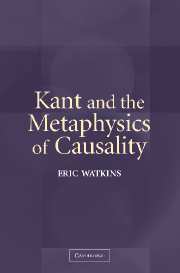Book contents
- Frontmatter
- Contents
- Acknowledgments
- A Note on Citations and Translations
- Introduction
- PART I CAUSALITY IN CONTEXT
- 1 Pre-established Harmony versus Physical Influx
- 2 Kant's Pre-Critical Theory of Causality
- PART II CAUSALITY IN THE CRITICAL PERIOD
- PART III CAUSALITY AND CONSEQUENCES
- Conclusion
- Bibliography
- Index
1 - Pre-established Harmony versus Physical Influx
Published online by Cambridge University Press: 12 January 2010
- Frontmatter
- Contents
- Acknowledgments
- A Note on Citations and Translations
- Introduction
- PART I CAUSALITY IN CONTEXT
- 1 Pre-established Harmony versus Physical Influx
- 2 Kant's Pre-Critical Theory of Causality
- PART II CAUSALITY IN THE CRITICAL PERIOD
- PART III CAUSALITY AND CONSEQUENCES
- Conclusion
- Bibliography
- Index
Summary
INTRODUCTION
To understand Kant's views on causality throughout his career, one should perhaps begin at the beginning. When Kant interrupted his studies at the university to settle his father's estate and was in the process of publishing his first book in 1746, what might his background knowledge on the issue of causality have included? What figures would have been important to him and what positions would have represented the primary options? What arguments, objections, and issues would he have thought of as standing in need of engagement or further analysis? What would have been perceived as a significant contribution to the state of the debate at this time? That is, what questions had not been answered satisfactorily and what questions still needed to be asked? It is the point of this chapter to explore some of the main currents in German philosophy pertaining to the issue of causality from Leibniz's death, in 1716, to Kant's first publication just over three decades later.
Since Leibniz's influence during the first half of the eighteenth century in Germany was pervasive, it is necessary to start with his views on causality in order to see the ways in which later figures, even his “followers,” would appropriate different aspects of his position, modifying them to their own ends and specifying them in ways that he might not have condoned. On the issue of causality, Leibniz is the first or, at the very least, most famous proponent of a doctrine called “pre-established harmony.”
Information
- Type
- Chapter
- Information
- Kant and the Metaphysics of Causality , pp. 23 - 100Publisher: Cambridge University PressPrint publication year: 2004
